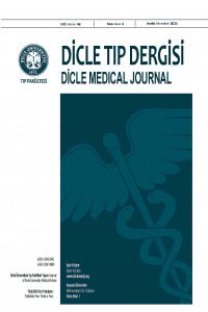The Effect of Maternal Hypothyroidism on Fetal Umbilical Cord Brain-Derived Neurotrophic Factor Levels
Gebelik, maternal hipotiroidi, beyin kaynaklı nörotrofik faktör (BDNF), levotiroksin
Determining a Safe Time for Oral Intake Following Pediatric Sedation
-,
___
- Abalovich M, Amino N, Barbour LA, et al. Management of thyroid dysfunction during pregnancy and postpartum: an Endocrine Society Clinical Practice Guideline. J Clin Endocrinol Metabol 2007;92:S1-47.
- Kıskaç M, Helvacı A, Zorlu M, et al. Subklinik hipotiroidili hastalardaki QT dispersiyonunun ötiroid hastalarla karşılaştırılması.
- Dicle Tıp Derg 2010;37:129-133.
- Burrow GN, Fisher DA, Larsen PR. Maternal and fetal thyroid
- function. New Engl J Med 1994;331:1072-1078.
- Stagnaro-Green A, Abalovich M, Alexander E, et al. Guidelines
- of the American Thyroid Association for the diagnosis and management of thyroid disease during pregnancy and postpartum. 2011;21:1081-1125.
- Wilson KL, Casey BM, McIntire DD, et al. Subclinical thyroid
- disease and the incidence of hypertension in pregnancy. Obstetr Gynecol 2012;119:315-320.
- Casey BM, Dashe JS, Wells CE, et al. Subclinical hypothyroidism
- and pregnancy outcomes. Obstetr Gynecol 2005;105:239-245.
- Haddow JE, Palomaki GE, Allan WC, et al. Maternal thyroid
- deficiency during pregnancy and subsequent neuropsychological
- development of the child. New Engl J Med 1999;341:549-555.
- Li Y, Shan Z, Teng W, et al. Abnormalities of maternal thyroid
- function during pregnancy affect neuropsychological development of their children at 25-30 months. Clin Endocrinol 2010;72:825-829.
- Huang EJ, Reichardt LF. Neurotrophins: roles in neuronal
- development and function. Ann Rev Neurosci 2001;24:677-736.
- Yamada K, Nabeshima T. Brain-derived neurotrophic factor/TrkB signaling in memory processes. J Pharmacol Sci 2003;91:267-270.
- Williams GR. Neurodevelopmental and neurophysiological actions of thyroid hormone. J Neuroendocrinol 2008;20:784-794.
- Henrichs J, Bongers-Schokking JJ, Schenk JJ, et al. Maternal
- thyroid function during early pregnancy and cognitive functioning in early childhood: the generation R study. J Clin Endocrinol Metab 2010;95:4227-4234.
- Tekin YB, Güven ESG. Gebelikte tiroid hastalıkları ve neonatal sonuçları. Jinekoloji-Obstetrik ve Neonatoloji Tıp Derg 2014;11:150-153.
- Flock A, Weber SK, Ferrari N, et al. Determinants of brainderived
- neurotrophic factor (BDNF) in umbilical cord and maternal serum. Psychoneuroendocrinology 2016; 63:191-197.
- ISSN: 1300-2945
- Yayın Aralığı: 4
- Başlangıç: 1963
- Yayıncı: Cahfer GÜLOĞLU
Association of Anthropometric Measurement Methods with Cardiovascular Disease Risk in Turkey
Kaan SÖZMEN, Belgin ÜNAL, Sibel SAKARYA, Gönül DİNÇ, Nazan YARDIM, Bekir KESKİNKILIÇ, Gül ERGÖR
Maternal Hipotiroidinin Fetal Umblikal Kord Beyin Kaynaklı Nörotrofik Faktör Düzeylerine Etkisi
Hüsnü ALPTEKİN, Hatice IŞIK, Nazife ALPTEKİN, Yusuf TANRIKULU, Emel ŞAHİN
Üst Gastrointestinal Sistem Kanamalı Hastaların Epidemiyolojisi ve Endoskopik Bulguları
MEHMET SUAT YALÇIN, BANU KARA, Nevin A. ÖZTÜRK, Şeymus ÖLMEZ, Burçak E. TAŞDOĞAN, Adnan TAŞ
The Assessment of Children’s Socio-Demographic Features at the Adolescent Outpatient Clinic
Y. Kenan HASPOLAT, Müsemma KARABEL, Duran KARABEL, Selvi KELEKCİ, Tuba TUNCEL, Velat ŞEN, Ünal ULUCA, İlhan TAN
İkinci Basamak Bir Merkezde Yapılan Yenidoğan İşitme Tarama Testlerinin Değerlendirilmesi
Ayşe ÇAKAL, Zerrin AŞÇI, Abdülkadir BUCAK, Beyhan YILMAZ, Emel AYTUĞ
Malign Adneksiyal Kitlelerin Tanısında Donuk (Frozen) Kesit İncelemesinin Doğruluğu
Nuri Yıldırım, Alkım Şahingöz Yıldırım, Ahmet Ergenoğlu, Ahmet Yeniel, Osman Zekioğlu, Necmettin Özdemir, M. Coşan Terek
Rastlantısal Prostat Kanseri Tanısında Pozitif Prediktif Değerler
Caner Ediz, Ayşe Nur İHVAN, Nermin KOÇ, Cumhur Selçuk TOPAL, Hüseyin HAYIT
Clinicohematological Profile of Pancytopenia: A Study from a Tertiary Care Hospital
Monica GUPTA, Abha CHANDNA, Sanjay KUMAR, Sant Prakash KATARİA, Sonia HASİJA, Gajender SINGH, Rajeev SEN
Laparoskopik Ürolojik Cerrahi Başlangıç Deneyimlerimiz
Selçuk Altın, Ramazan Topaktaş, Ali Akkoç, Cemil Aydın, Reha Girgin, Zeynep Aydın, Kadir Yıldırım
Serum Growth Arrest Specific Protein 6 (Gas-6) Levels in Patients with Schizophrenia
Fethullah GERİN, Aybala TOPRAK, Hayriye ERMAN, Sadettin DÜRÜYEN, Alper BAŞ
